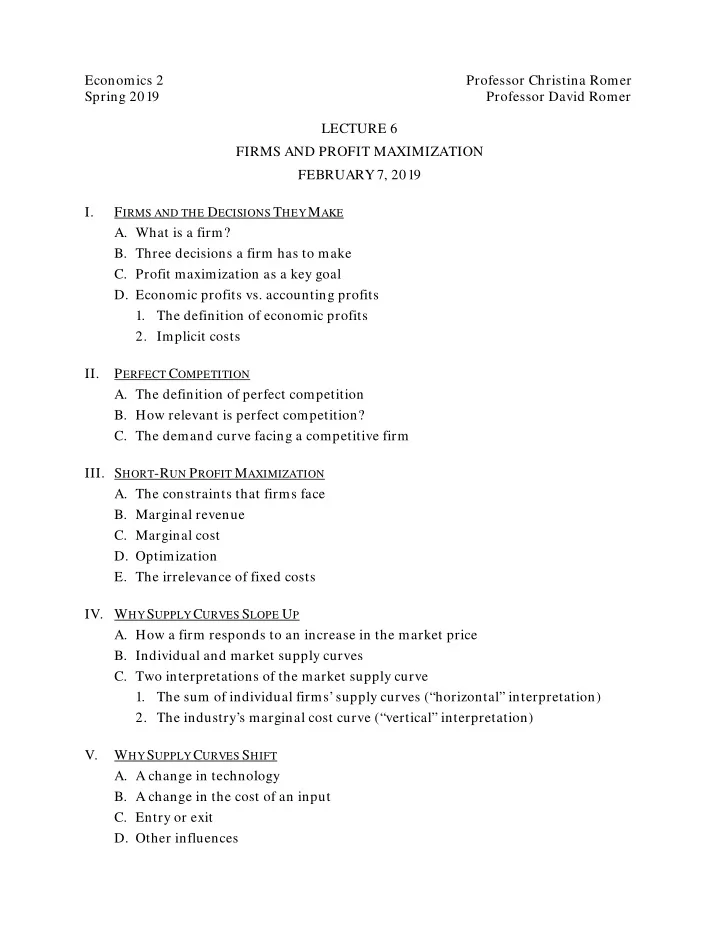

Economics 2 Professor Christina Romer Spring 2019 Professor David Romer LECTURE 6 FIRMS AND PROFIT MAXIMIZATION FEBRUARY 7, 2019 I. F IRMS AND THE D ECISIONS T HEY M AKE A. What is a firm? B. Three decisions a firm has to make C. Profit maximization as a key goal D. Economic profits vs. accounting profits 1. The definition of economic profits 2. Implicit costs II. P ERFECT C OMPETITION A. The definition of perfect competition B. How relevant is perfect competition? C. The demand curve facing a competitive firm III. S HORT -R UN P ROFIT M AXIMIZATION A. The constraints that firms face B. Marginal revenue C. Marginal cost D. Optimization E. The irrelevance of fixed costs IV. W HY S UPPLY C URVES S LOPE U P A. How a firm responds to an increase in the market price B. Individual and market supply curves C. Two interpretations of the market supply curve 1. The sum of individual firms’ supply curves (“horizontal” interpretation) 2. The industry’s marginal cost curve (“vertical” interpretation) V. W HY S UPPLY C URVES S HIFT A. A change in technology B. A change in the cost of an input C. Entry or exit D. Other influences
Economics 2 Christina Romer Spring 2019 David Romer L ECTURE 6 Firms and Profit Maximization February 7, 2019
Announcements • The Economics Department offers drop-in Econ 2 tutoring. Information about hours and locations is at https://www.econ.berkeley.edu/undergrad/home/ t utoring. • The Student Learning Center offers drop-in Econ 2 tutoring, M–Th 10AM–2PM in the SLC Atrium at the Cesar Chavez Student Center. Additional formats of service can be found at http://slc.berkeley.edu/econ.
Announcements • A detailed answer sheet to Problem Set 1 will be posted this evening.
I. F IRMS AND THE D ECISIONS T HEY M AKE
Three Decisions a Firm Has to Make • Short-run choice of output: How much to produce today with the existing set-up? • Long-run choice of output: Expand or contract? Exit the industry? Enter the industry? • Both short-run and long-run – the choice of input mix: What combination of inputs (labor, capital, raw materials, and so on) to use to produce the output?
Profit Maximization • We assume that firms’ objective is to maximize their economic profits. • The definition of economic profits: Profits = Total Revenue – Total Costs, where: • Total Revenue = Price Quantity • • Total Cost = Opportunity Cost of All Inputs
II. P ERFECT C OMPETITION
Perfect Competition • Each firm can sell as much or as little as it wants at the prevailing market price. • Three reasons for starting our study of firm behavior with the case of perfect competition: • It’s a reasonable description of important parts of the economy. • It’s relatively simple. • It’s an important reference point.
Individual-Household and Market Demand Curves Individual Household Market P P Q q
Market and Individual-Firm Demand Curves Market Individual Firm P P q Q
III. S HORT -R UN P ROFIT M AXIMIZATION
Marginal Revenue: The Additional Revenue Associated with Producing One More Unit MR (in $) q
Different Types of Costs • Fixed costs: Costs that do not depend on how much is produced. • Variable costs: Costs that do vary with how much is produced. • Total costs: The sum of fixed and variable costs. • Marginal cost: The change in total costs from producing one more unit. • Note: Since fixed costs do not change when one more unit is produced, marginal cost is also equal to the change in variable costs from producing one more unit.
Marginal Cost: The Additional Cost Associated with Producing One More Unit mc (in $) q
The Profit-Maximizing Level of Output for a Perfectly Competitive Firm P q
Condition for Profit-Maximization
IV. W HY S UPPLY C URVES S LOPE U P
Impact of a Rise in the Market Price P mc P 1 mr 1 q 1 q
Market and Individual-Firm Supply Curves Market Individual Firm P P q Q
Two Interpretations of the Market Supply Curve • The sum of individual firms’ supply curves (“horizontal” interpretation). • The industry’s marginal cost curve (“vertical” interpretation).
The Industry Supply Curve Is the Industry Marginal Cost Curve – Example Suppose there are 100 firms. Each has MC at 1000 units of • $5, MC at 2000 units of $6, etc. $ $ 7 7 6 6 mc i (also s i ) 5 5 4 4 3 3 2 2 1 1 0 0 q Q 0 100K 200K 300K 2K 3K 0 1K
V. W HY S UPPLY C URVES S HIFT
An Improved Production Technology Market Individual Firm mc 1 P P S 1 q Q
An Increase in the Price of an Input Market Individual Firm P P mc 1 S 1 q Q
Entry of New Firms Market Individual Firm P P mc 1 S 1 q Q
Other Possible Reasons the Supply Curve Could Shift
Recommend
More recommend